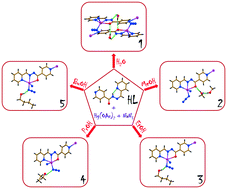Polar protic solvent-trapping polymorphism of the HgII-hydrazone coordination polymer: experimental and theoretical findings†
Abstract
A novel series of HgII coordination polymers with a general formula [HgL(N)3]n·n(solv) (HL = 2-pyridinecarbaldehyde isonicotinoylhydrazone; n(solv) = 0.5H2O (1), 2MeOH (2), EtOH (3), PrOH (4) and 0.5BuOH (5)) was prepared and characterized by elemental analysis, IR spectroscopy and single crystal X-ray diffraction. The crystal structure of HL, elucidated by X-ray diffraction, comprises two independent molecules in the asymmetric unit cell, each of which is stabilized by an intramolecular hydrogen bond formed between the carbohydrazide hydrogen atom and the 2-pyridyl nitrogen atom. Crystal structures of 1–5 each reveal a similar 1D zigzag metal–organic chain [HgL(N)3]n, where the organic ligands bridge metal centers. These chains are extended into distinct 2D supramolecular nets by strong hydrogen bonds with the solvent molecules and/or short Hg⋯N supramolecular contacts. These networks were topologically classified as the hcb in 1 and fes in 2–5 underlying nets. On comparing the H-bonding patterns, it can be concluded that the lattice water molecules in 1 and methanol molecules in 2 form H-bonding interactions with the O and amide N atoms of L in the former structure and the O atom of L in the latter structure. In the remaining coordination compounds, the lattice solvent prefers the azide N atom for H-bonding. Furthermore, the existence of Hg⋯N interactions in 2–5 and their absence in 1 clearly highlights the importance of the size and polarity of the solvents on the self-assembly generation of HgII coordination polymers. A broad network of intermolecular π⋯π stacking interactions, formed between the pyridyl fragments, provide further reinforcement of crystal packing patterns in the structures of HL and 2–5. DFT based charge and energy decomposition scheme (ETS-NOCV) was applied to characterize the obtained polymers.



 Please wait while we load your content...
Please wait while we load your content...